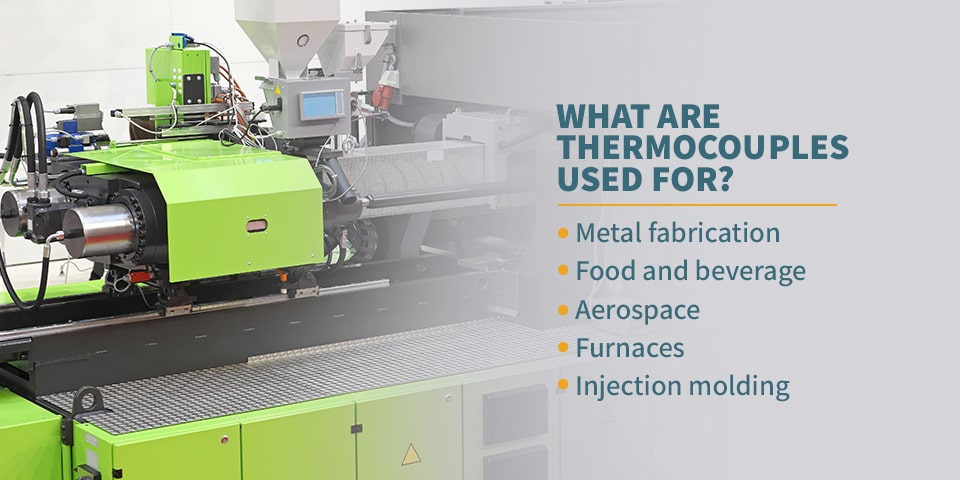
What Is a Thermocouple and How Many Types Are There?
Temperature sensors are a necessity in modern data centers due to the sheer amount of heat data center equipment generates. Monitoring your data center’s ambient temperature helps you protect your equipment by connecting to your environmental control systems.
Proper temperature management is also necessary for complying with standards from the American Society of Heating, Refrigerating and Air-Conditioning Engineers (ASHRAE). The most widely used data center temperature control solutions often incorporate thermocouples in their monitoring equipment.
What Is a Thermocouple?
A thermocouple is a type of temperature sensor formed from two metal wires of different compositions. They measure temperature using differential calculations from a known reference junction, also known as a cold junction, and a probe connected to the object you wish to measure.
Connecting two different wires of different temperatures triggers the Seebeck Effect, which produces a voltage difference between them. The thermocouple measures this difference and uses it to compute the temperature of the object being measured.
Different combinations of metals create thermocouples with differing capabilities. For example, some combinations can handle more extreme temperature ranges than others. This produces highly specialized thermocouples for demanding applications like jet engine temperature monitoring.
How Many Types of Thermocouples Are There?
Providing a solid number of thermocouple types is difficult due to the constant changes within the landscape. Manufacturers are constantly creating new types by experimenting with different metal pairings, and older models become obsolete over time.
The different types of thermocouples are classified by the materials used in each leg. Each pairing produces a thermocouple suited to a new environment with various environmental capacities.
However, researchers have named a few standardized classifications to maximize outcome potentials. The two primary groups are:
- Base: The “homebody” thermocouples contain base metals like iron, copper, nickel and chromium. While they’re excellent for everyday use in household appliances, they are unsuitable for more extreme environments.
- Noble: The “upper crust,” “rarefied” and “exotic” thermocouple classes use more costly noble metals such as rhodium, rhenium, tungsten and platinum. They’re better suited for harsh environments such as data centers and manufacturing facilities because they can handle much higher temperatures.
Beneath these two overarching groups, there are nine main types, each classified by a letter:
- K: The positive leg is chromel, and the negative leg is alumel. The temperature range is -454 to 2,501.6 degrees Fahrenheit. K sensors are the most commonly used thermocouple type.
- B: The positive leg is platinum with 6% rhodium, and the negative leg is platinum with 30% rhodium. The temperature range is 32 to 3,308 degrees Fahrenheit.
- E: The positive leg is chromel, and the negative leg is constantan. The temperature range is -454 to 1,832 degrees Fahrenheit.
- J: The positive leg is iron, and the negative leg is constantan. The temperature range is -346 to 1,400 degrees Fahrenheit.
- N: There are two subtypes of Type N thermocouples — N(AWG14) and N(AWG28). Both contain positive legs of nicrosil and negative legs of nisil. N(AWG14) can handle temperatures from -454 to 752 degrees Fahrenheit, and N(AWG28) can withstand from 32 to 2,372 degrees Fahrenheit.
- R: The positive leg contains platinum with 23% rhodium, and the negative leg contains pure platinum. The temperature range is -58 to 3,214.4 degrees Fahrenheit.
- S: The positive leg contains platinum with 10% rhodium, and the negative leg is pure platinum. The temperature range is -58 to 3,214.4 degrees Fahrenheit.
- T: The positive leg is pure copper, and the negative leg is constantan. The temperature range is -454 to 752 degrees Fahrenheit.
- C: The positive leg is tungsten with 5% rhenium, and the negative leg is tungsten with 26% rhenium. The temperature range is 32 to 4,208 degrees Fahrenheit.
There is also a W classification for thermocouples containing tungsten, which are named according to the proportion of rhenium in their positive leg. For example, a C-type thermocouple, which has a positive leg containing 5% rhenium and 95% tungsten, falls under the W5 category.
W thermocouples without a number do not contain rhenium. These thermocouples have the highest temperature limits of all the types, with the most durable withstanding more than 4,200 degrees Fahrenheit (2,320 degrees Celsius).

What Are Thermocouples Used For?
Thermocouples are the most common temperature sensor in use today due to their quick response times and ability to power themselves. They have many uses across almost every industry, from automotive manufacturing to consumer appliances.
Some of the most common applications for thermocouples include the following:
- Metal fabrication: Type K, N, R and S thermocouples are some of the only sensors capable of conducting contact temperature measurements of molten metal.
- Food and beverage: Thermocouples are suitable for various use cases in the food and beverage industry, including food penetration probes, hotplate control and clean-in-place sensors.
- Aerospace: Rugged thermocouples can withstand the extreme vibrations and pressure changes that airplanes experience, such as in jet engines.
- Furnaces: With the proper sheath and mounting configuration, a thermocouple can withstand high furnace temperatures during normal operation.
- Injection molding: J-type thermocouples can withstand a wide range of temperatures and are less sensitive to external noise than other types, making them ideal for monitoring temperatures in injection molding machines.
Thermocouples are also frequently used in IT applications such as data center temperature monitoring. Their cost-effectiveness and low power needs make them suitable for environments containing many other devices.
How Are Thermocouples Used in Data Centers?
Data center equipment produces a lot of heat. Allowing that heat to build up can cause serious damage to your equipment and put your personnel in danger.
Temperature sensors like thermocouples and thermistors help ensure your data center functions at safe temperatures. Monitoring often involves placing sensors strategically throughout your facility, including:
- All sides of your server racks
- Intake and discharge vents of your HVAC system
- All critical devices
K-type thermocouples are the most common type in data center applications. They also help you gauge your cooling system’s efficiency. Many data centers implement systems that overcool their facilities, which can inflate your energy bill. Installing a sensor system can help you determine whether your existing cooling strategy is working as it should.
Contact DataSpan for Reliable Temperature Monitoring Solutions
Working with a data center expert like DataSpan is the best way to optimize your data center’s environmental monitoring system. We’re vendor-agnostic and dedicated to improving energy efficiency within the industry, so you can rely on us to provide sustainable, high-quality systems.
Whether you operate a small facility or an enterprise data center spanning a whole campus, we can help you develop a custom solution for your facility’s unique needs. Contact us online or connect with your local DataSpan representative for more information.








